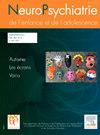La prescription de médicaments psychotropes chez l’enfant et l’adolescent en France : caractéristiques et évolution entre 2010 et 2023
Q4 Medicine
Neuropsychiatrie de l''Enfance et de l''Adolescence
Pub Date : 2025-01-07
DOI:10.1016/j.neurenf.2024.12.001
引用次数: 0
Abstract
Context
Questions related to the consumption of psychotropic medications among children and adolescents have garnered sustained interest in scientific literature and public debates at the international level. In France, prevalence data have not been updated since 2010. The aim of this article is to analyze the French National Health Data System Sample (ESND) to describe the trends in psychotropic medication use in the pediatric population between 2010 and 2023, as well as the various clinical, demographic, and social variables that may contribute to prescribing practices.
Methods
We conducted a systematic analysis of psychotropic medication consumption among individuals aged 0–17 in the ESND (2% of the French population) between 2010 and 2023, focusing particularly on the following drug classes: N05A antipsychotics, N05B anxiolytics, N05C hypnotics and sedatives, N06A antidepressants, N06B psychostimulants, N03 antiepileptics, and N04 antiparkinsonians.
Results
The incidence of psychotropic medication use among children and adolescents declined from 2.30% in 2011 to 2.14% in 2023. The prevalence of psychotropic medication use among those aged 3–17 rose from 3.25% in 2011 to 3.94% in 2023. More specifically, this prevalence increased from 2.32% in 2011 to 3.22% in 2023 among children aged 6–11. Among adolescents aged 12–17, it rose from 4.96% in 2011 to 5.49% in 2023. Between 2010 and 2023 the number of prescriptions per year per patient increased for most therapeutic classes, particularly for hypnotics (+137%), antidepressants (+88%), antiepileptics (+62%), antipsychotics (+50%), and psychostimulants (+40%). The duration of treatment varied significantly between therapeutic classes, being limited to one month for anxiolytics and antidepressants. Median treatment durations for other ATC classes were particularly long. The number of months of use increased by +76% between 2010 and 2023, rising from 80 months per 1000 individuals in 2010 to 138 months per 1000 individuals in 2023, with an acceleration in the period from 2021 to 2023. Poly-prescriptions were common and involved all medication classes. In 2022, 72% of psychotropic medications for children were prescribed by general practitioners, 7% by pediatricians, and 9% by psychiatrists and child psychiatrists. In 2022, 30% of children receiving at least one psychotropic prescription lived in socially disadvantaged conditions – a rate which was 50% for antipsychotics. Psychotropic medication use in children and adolescents increased during the COVID crisis and continued to rise until 2023.
Discussion and conclusion
The analysis of the ESND confirms a general increase in the prevalence of psychotropic medication use in the pediatric population, marked by a rise in the number of boxes per year per patient and a lengthening of treatment durations for many drug classes. Incidence remained stable and a slight decrease over the period, suggesting changes in prescribing practices. The rise in antidepressant and anxiolytic prescriptions since the COVID period is consistent with international data, while the continuous increase in psychostimulant use may represent a specifically French trend.
法国儿童和青少年精神药物处方:2010年至2023年的特点与演变
与儿童和青少年使用精神药物有关的问题在国际一级的科学文献和公开辩论中引起了持续的兴趣。在法国,患病率数据自2010年以来没有更新过。本文的目的是分析法国国家卫生数据系统样本(ESND),以描述2010年至2023年间儿科人群中精神药物使用的趋势,以及可能影响处方实践的各种临床、人口统计学和社会变量。方法系统分析2010年至2023年ESND(占法国人口的2%)0-17岁人群的精神药物使用情况,重点关注以下药物类别:N05A抗精神病药、N05B抗焦虑药、N05C催眠药和镇静剂、N06A抗抑郁药、N06B精神兴奋剂、N03抗癫痫药和N04抗帕金森药。结果儿童青少年精神药物使用率由2011年的2.30%下降到2023年的2.14%。3-17岁青少年精神药物使用率由2011年的3.25%上升至2023年的3.94%。更具体地说,6-11岁儿童的患病率从2011年的2.32%上升到2023年的3.22%。在12-17岁的青少年中,这一比例从2011年的4.96%上升到2023年的5.49%。在2010年至2023年期间,大多数治疗类药物每年每位患者的处方数量都有所增加,特别是催眠药(+137%)、抗抑郁药(+88%)、抗癫痫药(+62%)、抗精神病药(+50%)和精神兴奋剂(+40%)。治疗持续时间在不同治疗类别之间差异显著,抗焦虑药和抗抑郁药限制在一个月。其他ATC类的中位治疗持续时间特别长。从2010年到2023年,使用手机的月数增加了76%,从2010年的每1000人80个月增加到2023年的每1000人138个月,并在2021年到2023年期间加速增长。多重处方很常见,涉及所有药物类别。2022年,72%的儿童精神药物由全科医生开具,7%由儿科医生开具,9%由精神科医生和儿童精神科医生开具。2022年,在接受至少一种精神药物处方的儿童中,有30%生活在社会弱势环境中,而服用抗精神病药物的儿童中这一比例为50%。在COVID危机期间,儿童和青少年使用精神药物的情况有所增加,并持续上升至2023年。讨论和结论ESND的分析证实了儿科人群中精神药物使用的普遍增加,其特征是每位患者每年的药箱数量增加,许多药物类别的治疗持续时间延长。发病率保持稳定,并在此期间略有下降,这表明处方做法发生了变化。自COVID期间以来抗抑郁药和抗焦虑药处方的增加与国际数据一致,而精神兴奋剂使用的持续增加可能代表了法国特有的趋势。
本文章由计算机程序翻译,如有差异,请以英文原文为准。
求助全文
约1分钟内获得全文
求助全文
来源期刊

Neuropsychiatrie de l''Enfance et de l''Adolescence
Medicine-Pediatrics, Perinatology and Child Health
CiteScore
0.60
自引率
0.00%
发文量
61
期刊介绍:
Organ of the Société française de psychiatrie de enfant et de adolescent, Neuropsychiatrie de enfance et de adolescence tackles all fields of child-adolescent psychiatry and offers a link between field and clinical work. As a reference and training tool for students and practitioners, the journal publishes original papers in child psychiatry as well as book reviews and conference reports. Each issue also offers a calendar of the main events dealing with the speciality.
 求助内容:
求助内容: 应助结果提醒方式:
应助结果提醒方式:


